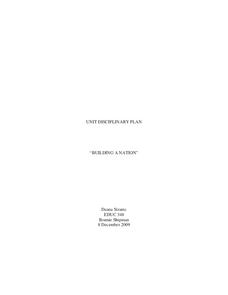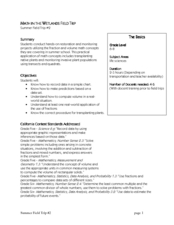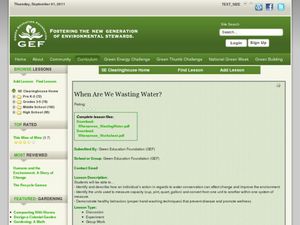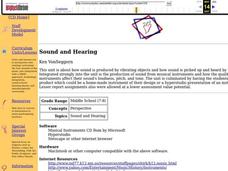Curated OER
Minting a New Mint
Students explore why the Founding Fathers felt it was necessary to have a solitary form of money used throughout the land. Students create their own money systems and have a class sale to simulate the confusion of multiple forms of...
Curated OER
Math: a World of Symmetry
Students expand their knowledge of quadrilaterals and identify basic symmetrical forms. Over three weeks, they explore the math, application, and discussion of symmetry. After conducting Internet research, students create symmetrical...
Curated OER
Mathematical Techniques - Basic Graphing
Students are introduced to significant figures and how to add, subtract, multiply and divide them. In a group, they practice plotting data points from a table to a graph and labeling all axes. They calculate the slope and y-intercept and...
Curated OER
Let's Graph It!
Students graph the height of others in centimeters and inches, find the slope of line in order to calculate the conversion factor between centimeters and inches.
Curated OER
Making The Height
Twelfth graders apply estimation techniques to determine how high any one basketball player can jump.
Curated OER
Math: Equal Area Triangles
Pupils examine a math worksheet and determine how to divide a single triangle into four of equal area. Using geometric principles, they sketch two additional ways to divide into into four equal triangles. To conclude, students explain...
Curated OER
FDR's Fireside Chat on the Purposes and Foundations of the Recovery Program
High schoolers discuss how they get information on important events or activities that occur in the national government today. They evaluate the New Deal, utilizing document analysis worksheets imbedded in this plan.
Curated OER
You say Avocado, I say Avogadro
Young scholars convert mole to mass to particles and vice versa. In this chemistry lesson, students discuss the importance of Avogadro's number. They apply what they have learned in a team competition.
Curated OER
Wig-wag Physics
Learners make observations on the effects of a small, medium and large weight on the movement of a wig-wag apparatus. They use their observations to develop a generalized inference of the effect weight on movement patterns.
Curated OER
The Aquatic Environment
Fifth graders focus on the various types of fish living in different water environments. In groups, they research the different methods used to fish and participate in experiments to determine the effects of mercury on fish, the...
Curated OER
Sun and Earth
Students explore the sun, its structure, how big it is and how far away it is. In this solar system instructional activity students complete a lab activity on dew point and weather.
Curated OER
Masks: History and Artistry
Students research masks and their purposes,. They listen to the teacher read books about masks. Students study techniques for working with clay, they create masks from clay. Students take pictures of the process and the finished project,...
Curated OER
Building A Nation
Students build their own nation in groups where they create a name, flag, declaration of independence, form of government, mathematical layout, and more. In this nation lesson plan, students also provide a scale drawing of their nation...
Curated OER
Math in the Wetlands Field Trip
Get your class out in the environment for hands on math activities. For this wetlands lesson, learners transplant native plants, calculate how much soil is needed, and perform math activities based on this experience. They then make...
Curated OER
Severe Weather Trackers
Young scholars explore weather terminology and the jobs that are associated with it. In this weather activity students write about thunderstorms and make a tornado.
Curated OER
Character Education: Integrity
Students understand the definition of integrity and explain quotes about it. In this integrity lesson, students apply quotes about integrity to a personal experience and write about it.
Curated OER
Aqueduct Architecture: Moving Water to the Masses in Ancient Rome
Ninth graders compare ancient and modern technology in water transporting. In this lesson on the evolution of the aqueduct, 9th graders build a working aqueduct model and examine its components. They explain the importance and use of the...
Curated OER
Machines: Designing Form and Function
High schoolers design a boat model with simplified steam engine. In this ecology lesson, students compare renewable and nonrenewable energy sources. They determine the efficiency of their boat model.
Curated OER
Numbers in Art
Young scholars choose a number from one to twelve and tell a number story about it. They listen to the teacher read "Numbers in Art" by Lucy Micklethwait. Students choose three numbers from one to twelve and view works of art while...
Alabama Learning Exchange
Float or Sink?
Experiment with mass and density as scholars figure out what makes things float or sink. First, they watch a podcast introducing these concepts. Be sure to use the comprehension question to test their understanding. Young scientists...
Curated OER
Minnesota-China Connections:What Time Is It?
Learners calculate the time difference between Beijing, China and their local community. They discuss how time difference affects intercultural communication.
Curated OER
When Are We Wasting Water
Students study water conservation. In this water conservation activity, students participate in a water conservation experiment. Students discover how to conserve water while washing their hands.
Curated OER
Learning the Letters
Students identify the letters of the alphabet. In this letters lesson, students use an iPad to play games, draw pictures, and listen to videos about the alphabet. They use pipe cleaners to create their name.
Curated OER
Sound and Hearing
Students discover how sound is produced by objects and picked up and heard by humans. Using musical instruments, they identify how the quality can affect the loudness, pitch and tone of the sound. They develop their own instrument or a...























